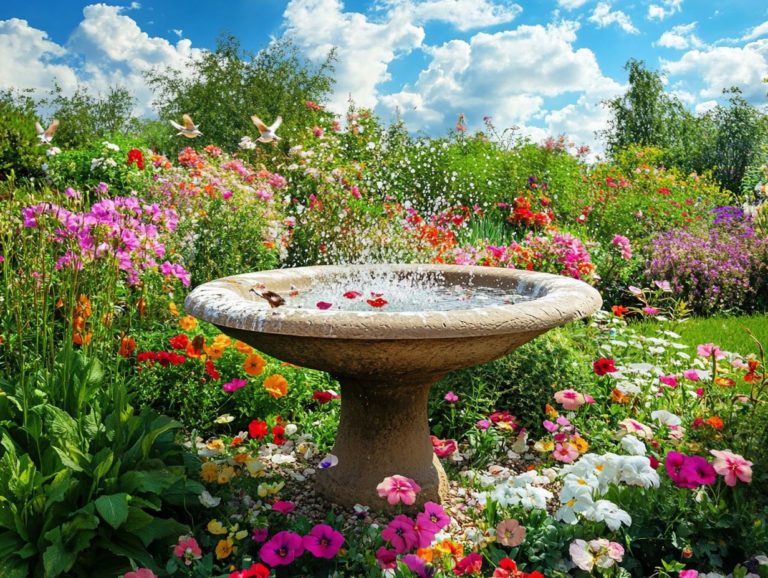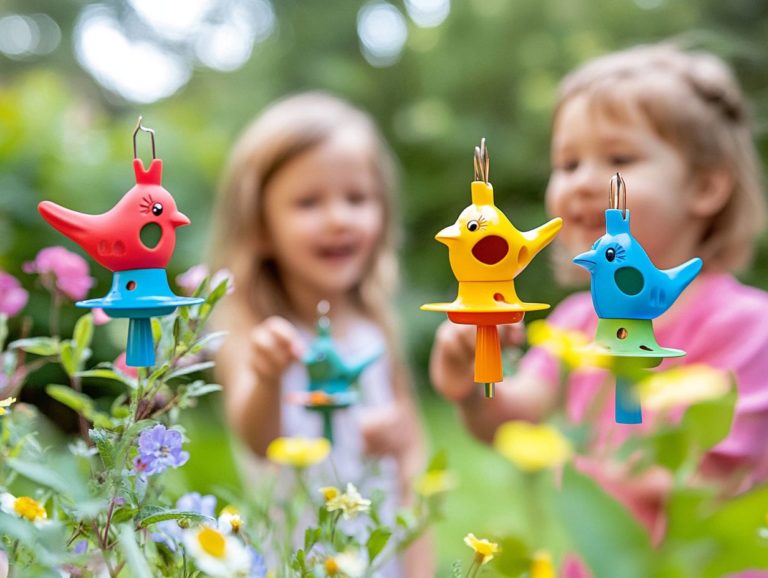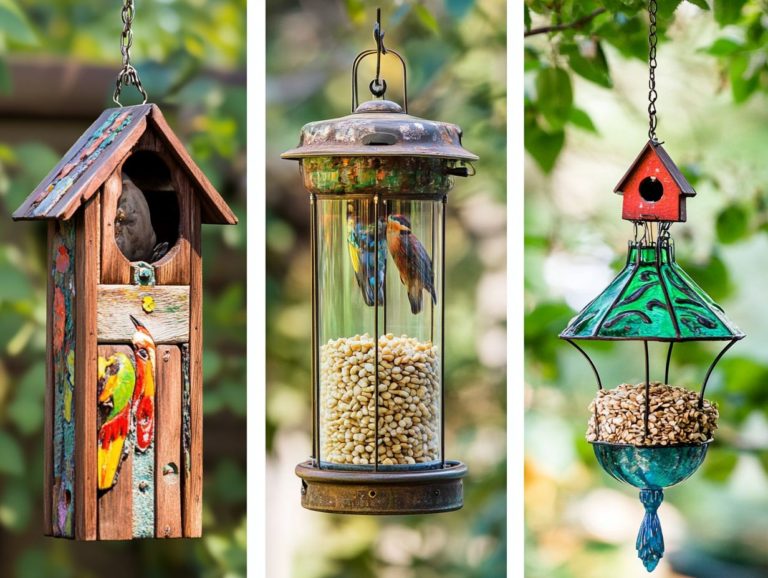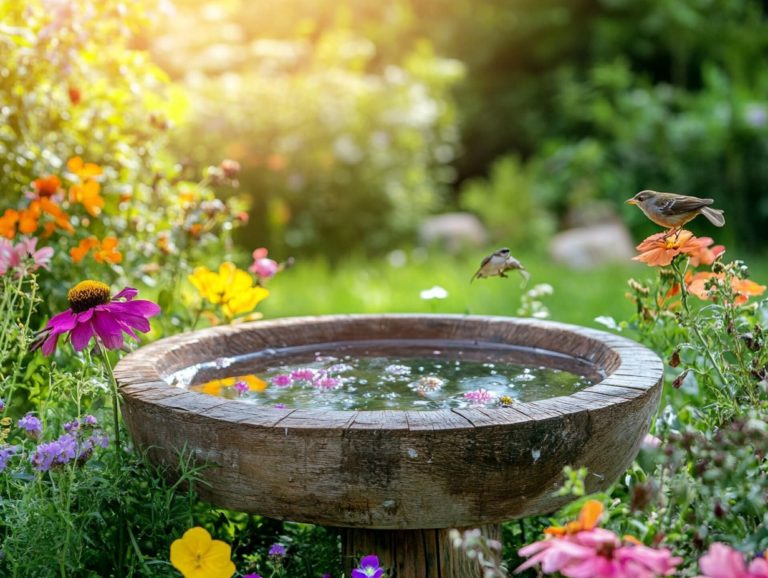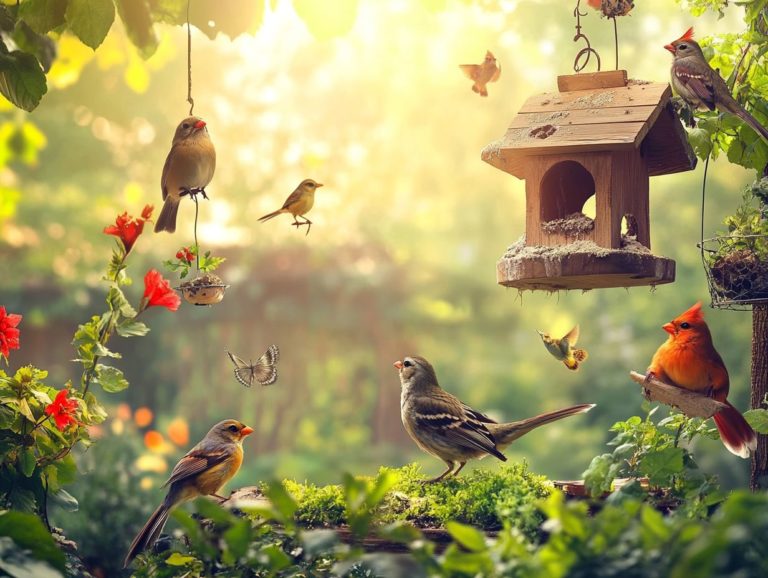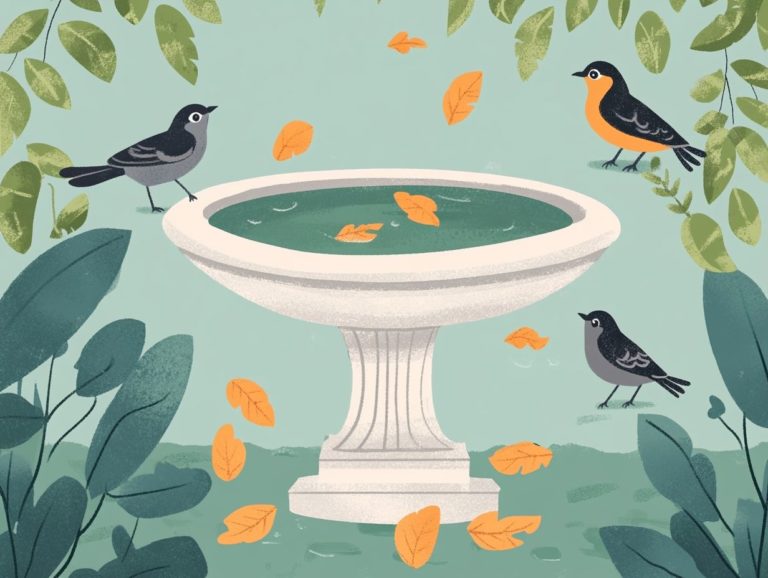The 5 Best Bird Feeders for Your Backyard
Birdwatching can turn your backyard into a vibrant haven. Selecting the right feeder is crucial for attracting a delightful variety of feathered friends.
This guide introduces you to five best types of bird feeders: platform, hopper, tube, suet, and window. Each is designed to cater to different bird species and their unique preferences.
You’ll also find essential factors to consider when choosing a feeder, such as maintenance, location, price, and durability.
Elevate your birdwatching experience and enjoy the beauty of nature right outside your window!
Contents
- Key Takeaways:
- 1. Platform Feeders
- 2. Hopper Feeders
- 3. Tube Feeders
- 4. Suet Feeders
- 5. Window Feeders
- Factors to Consider When Choosing a Bird Feeder
- What Types of Birds Will Be Attracted to Each Type of Feeder?
- How Much Maintenance Does Each Feeder Require?
- What Is the Best Location for Each Type of Feeder?
- Which Feeders Are Best for Different Types of Bird Food?
- What Is the Price Range for Each Type of Feeder?
- How Durable Are Each Type of Feeder?
- What Are the Pros and Cons of Each Type of Feeder?
- What Are Some Additional Features to Look for in a Bird Feeder?
- How Can You Attract More Birds to Your Feeder?
- What Are Some Common Mistakes to Avoid When Using Bird Feeders?
- Frequently Asked Questions
- What are the 5 best bird feeders for my backyard?
- How do I choose the right bird feeder for my backyard?
- What is a tube feeder and why is it a popular choice?
- Can I use a platform feeder for ground-feeding birds?
- What is the benefit of using a suet feeder in my backyard?
- How can I keep my hummingbird feeder clean and safe for birds?
Key Takeaways:
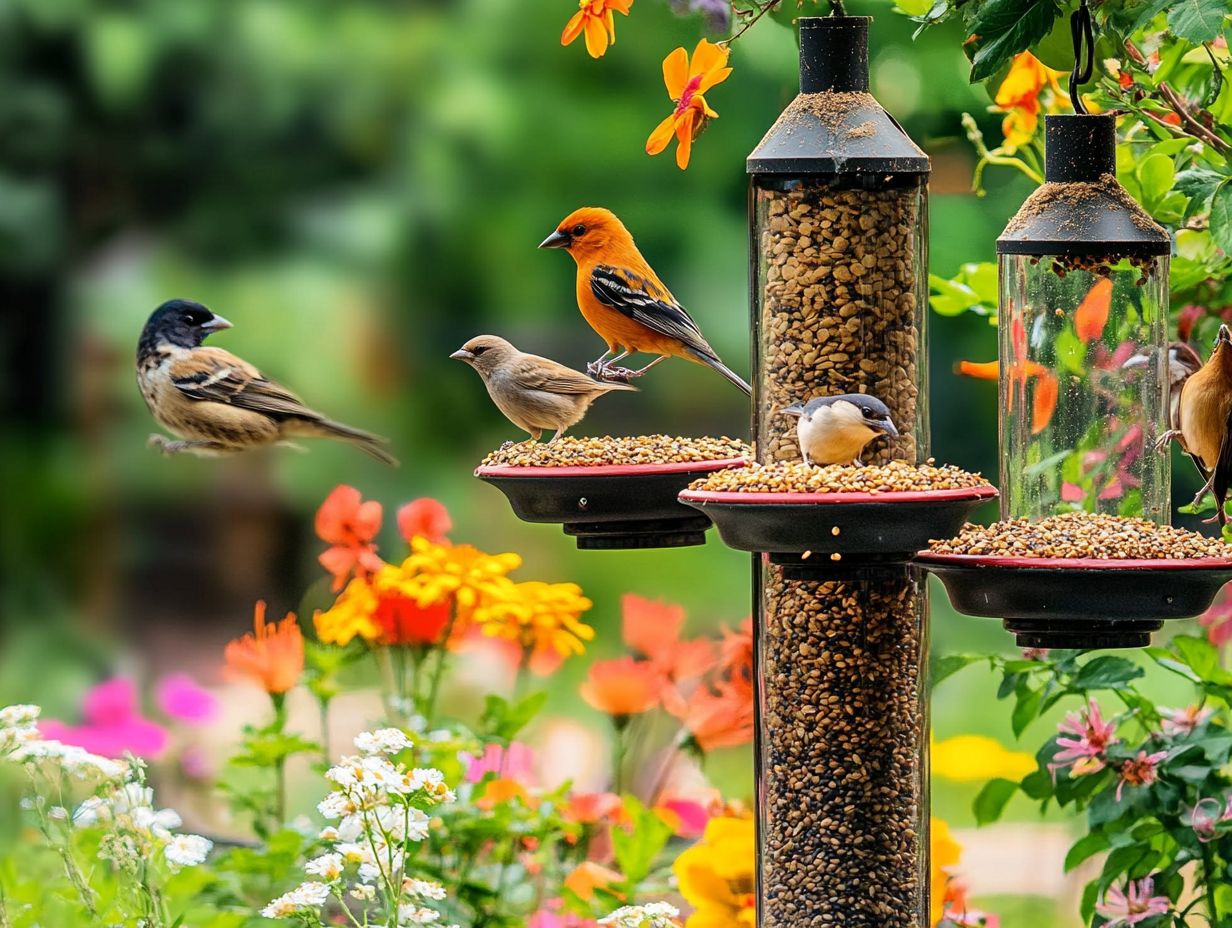
- Platform feeders are great for attracting a wide variety of birds and can hold multiple types of bird food.
- Hopper feeders are easy to maintain and can attract larger birds such as cardinals and blue jays.
- Tube feeders are ideal for smaller birds and have a long lifespan, but require regular cleaning.
1. Platform Feeders
Platform feeders are a vital addition to your backyard birdwatching setup. They provide accessible feeding for many wild birds, from finches to sparrows. This enhances their health and supports bird conservation efforts in your outdoor space.
These feeders come in many styles that birds love, featuring spacious platforms that can accommodate multiple birds at once. Their open and inviting layout attracts a wider range of species, making them favorites among cardinals and jays.
Place the feeder near sheltering trees or shrubs to encourage more frequent visits. It’s a key element in your broader bird feeding strategy alongside tube and hopper feeders.
To keep your feathered friends safe, clean the feeder regularly to prevent disease. Reposition the feeder seasonally to match the birds’ changing feeding habits. With thoughtful positioning and maintenance, you can create a vibrant habitat that delights you and supports local wildlife.
2. Hopper Feeders
Hopper feeders catch the eye of bird enthusiasts thanks to their smart design that offers easy access to various seed types. They’re perfect for luring in diverse bird populations, from cardinals to chickadees, right in your backyard.
Typically, these feeders have a spacious container to hold seeds and a base that allows birds to perch comfortably while enjoying their meal. This design accommodates a wide range of species, from finches to jays, while keeping seeds dry and accessible, encouraging frequent visits from your feathered friends.
Experts, including those at the National Audubon Society, recommend using hopper feeders as a reliable food source during colder months when natural resources become scarce.
When choosing the right hopper feeder, consider factors like durability, ease of cleaning, and capacity. Also, think about the types of birds common in your area to ensure you attract a vibrant array of wildlife.
3. Tube Feeders
Tube feeders are some of the best bird feeders on the market, designed to accommodate various seed types, including thistle seeds that attract enchanting finches. Their removable bases make cleaning and maintenance a breeze.
These well-made feeders are constructed from durable materials and have a sleek design. They blend beautifully into any backyard aesthetic while efficiently catering to your avian visitors. If you’re looking for options suitable for little ones, check out the best bird feeders for children. With their vertical structure, tube feeders minimize seed spillage, ensuring that more seeds reach the birds instead of landing on the ground.
With multiple feeding ports, they attract a diverse array of bird species, from sparrows to chickadees. To maintain these feeders, simply refill as needed and wash them regularly to prevent mold buildup. When selecting the perfect tube feeder, consider the types of seeds favored by the local birds to enhance their feeding experience.
4. Suet Feeders
Suet feeders are a great way to attract woodpeckers and other insect-eating birds. They provide essential fats and proteins that help birds stay healthy during colder months.
These feeders typically feature a mesh or wire cage designed to securely hold suet cakes. The cakes release vital nutrients as birds peck at them. You’ll find a delightful variety of suet cakes available, including those infused with fruits, seeds, or insects, catering to the unique tastes of different bird species.
Experts recommend positioning your suet feeders in shaded areas to prevent melting in warmer weather. This ensures that your feathered visitors can easily spot them. To attract specific birds like nuthatches or chickadees, try different suet flavors. Keeping feeders clean also helps bring more birds to your garden.
5. Window Feeders
Window feeders offer you a remarkable birdwatching experience! You can observe wild birds up close as they feed, enhancing your enjoyment of the hobby and fostering a deeper connection with nature.
Designed to attach directly to your window, these feeders provide a noticeable way to attract a variety of bird species right to your home. Their straightforward installation makes them accessible for any bird lover, no matter your skill level.
Among the vibrant visitors you can attract are finches, chickadees, and cardinals, all drawn in by seeds or suet. To keep these feeders in top shape, it s essential to clean them regularly and refill them with fresh food. This ensures a safe dining experience for the birds.
This convenience not only beautifies your backyard but also elevates your birdwatching experience, bringing nature’s wonders within arm’s reach.
Factors to Consider When Choosing a Bird Feeder
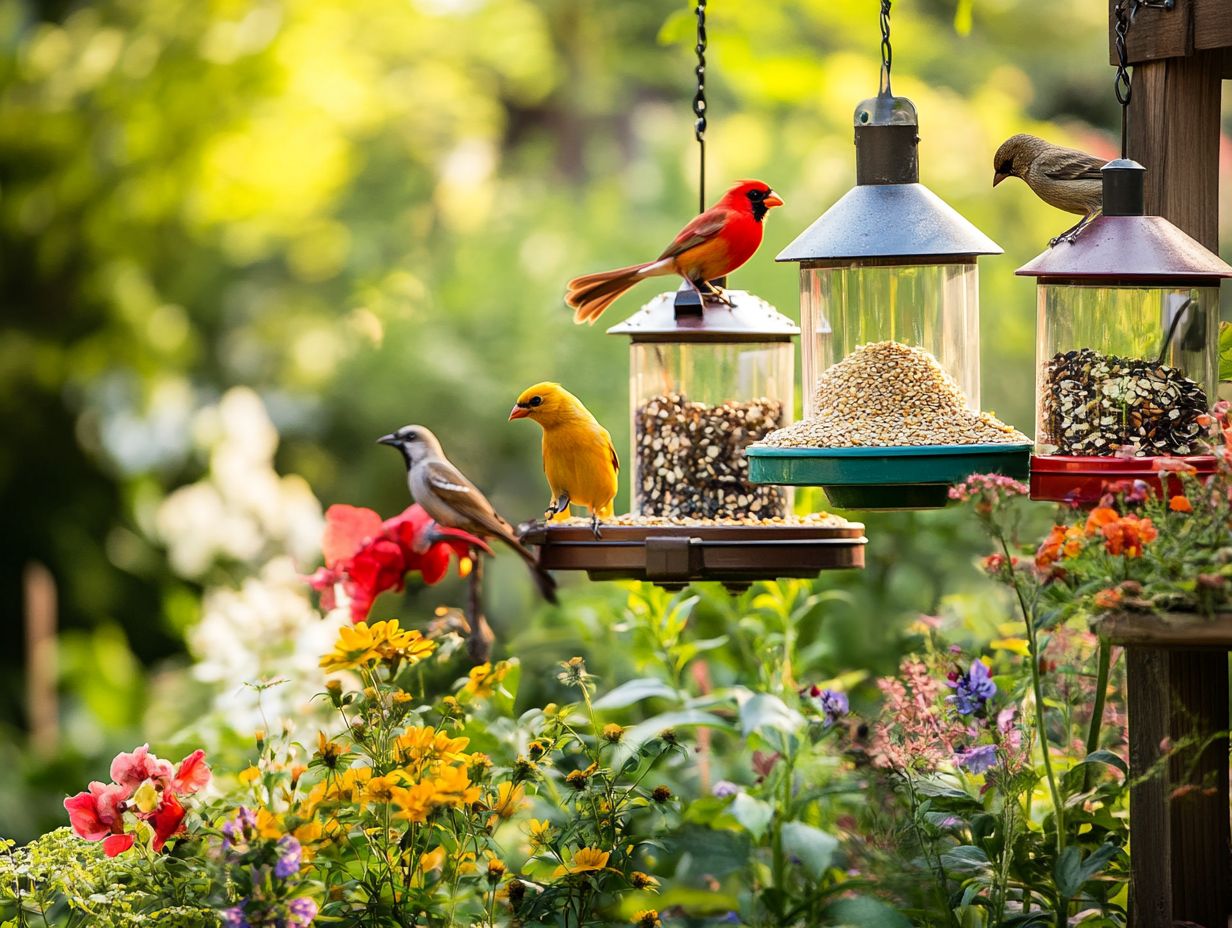
Choosing the right bird feeder involves several key factors. Consider the types of birds you want to attract, the various feeder styles available, and the unique environmental conditions that can influence feeding behavior and feeder upkeep in your area.
When thinking about where to place the feeder, evaluate whether it will be in a sunny spot, a shaded area, or nestled near shrubs. These elements can significantly impact visitation rates. Weather conditions matter too; heavy rain or strong winds might necessitate sturdier feeders to keep the feed dry and accessible.
Pay attention to local bird populations. If your area has a high number of finches, tube feeders filled with nyjer seeds a type of small seed that many birds love might be particularly effective.
The Cornell Lab of Ornithology suggests using specialized feeders tailored to specific species and their feeding habits. For optimal results, consider the best bird feeders for all-year usage, as advised by the National Audubon Society, which also recommends monitoring seasonal changes to adjust your feeder choices accordingly, maximizing the diversity and activity of birds in your backyard.
What Types of Birds Will Be Attracted to Each Type of Feeder?
Different types of bird feeders can attract a delightful array of bird species. Specific feeders like tube feeders and platform feeders are more effective for certain birds based on their feeding habits and preferences.
Take tube feeders, for example they’re a favorite among finches and small songbirds, as their narrow perches cater perfectly to these agile diners. On the flip side, platform feeders roll out the red carpet for larger birds like doves and jays, providing ample room for them to land comfortably.
If you’re keen on attracting the vibrant hummingbirds, a hummingbird feeder filled with a sugar-water solution is just the ticket. And let s not forget about suet feeders, which are irresistible to woodpeckers and other insect-eaters.
When selecting feeders, consider the local bird species in your area. For instance, if you want to attract goldfinches, a nyjer seed feeder might be your best bet. Place feeders in quiet, sheltered spots to keep them safe and accessible for your feathered visitors.
How Much Maintenance Does Each Feeder Require?
Maintenance requirements can vary significantly among different types of bird feeders. Some models are designed for easy cleaning, while others may require more effort to keep them functional and squirrel-proof.
Take tube feeders, for example. They often have removable parts that make cleaning a breeze. This allows you to maintain clean and healthy conditions for your feathered friends. In contrast, platform feeders and suet holders can be a bit of a challenge due to their design, requiring thorough scrubbing to fend off mold and bacteria.
To keep your feeders in top-notch condition, regular cleaning is essential. A simple solution of vinegar and water works wonders. Consider placing your feeders in shaded areas to reduce debris buildup from the elements and discourage unwanted pests.
Implement these strategies to ensure that your feeders remain inviting and safe havens for your avian visitors.
What Is the Best Location for Each Type of Feeder?
Placing your bird feeder in the best location is crucial for attracting a variety of bird species. By ensuring they feel safe and comfortable while feeding, you can enhance your birdwatching experience and elevate your outdoor space.
Experts recommend positioning feeders in spots that maximize visibility. This lets birds survey their surroundings while enjoying their meals. It’s also important to protect them from predators. Place feeders just a few feet away from cover like shrubs or trees to provide essential escape routes.
Accessibility is another key consideration. Aim for feeders that are easy to refill while offering you a clear view of the delightful antics of your feathered visitors. A location that captures the morning sun not only attracts birds but also keeps the feed dry, creating an inviting spot for those charming guests.
Which Feeders Are Best for Different Types of Bird Food?
Selecting the right bird feeder is essential for providing a variety of seed types and food options. For inspiration, check out the top 10 unique bird feeders for your yard. This ensures your backyard becomes a haven for many wild birds, from finches to woodpeckers, based on their unique dietary preferences.
Understanding how different feeders work with various food types can greatly enhance your birdwatching experience. For example, tube feeders are particularly good for holding seed blends that attract smaller birds, such as chickadees and goldfinches. In contrast, suet feeders are designed to entice woodpeckers and nuthatches, which love the rich fat in suet cakes. Hummingbird feeders are a must if you want to offer nectar-based options that lure in those vibrant little hummingbirds.
By grasping the best pairings, you can create an inviting atmosphere that encourages a wide range of species to visit and indulge.
What Is the Price Range for Each Type of Feeder?
The price range for bird feeders can vary significantly based on the type, features, and materials involved. Choosing high-quality options, such as those from Droll Yankees, provides you with durable designs that elevate your bird-feeding experience without straining your budget.
You can find simple tube feeders starting at around $20, while more intricate tray or platform feeders can soar to $100 or beyond. It s crucial to keep both initial costs and replacement frequency in mind, as wear and tear can impact your investment.
Experts suggest selecting feeders made from robust materials like metal or high-grade plastic, which can withstand the elements and last for years.
By choosing a reliable feeder, you can attract a diverse range of bird species and enjoy a more fulfilling feeding experience. This makes that initial investment feel worthwhile!
How Durable Are Each Type of Feeder?
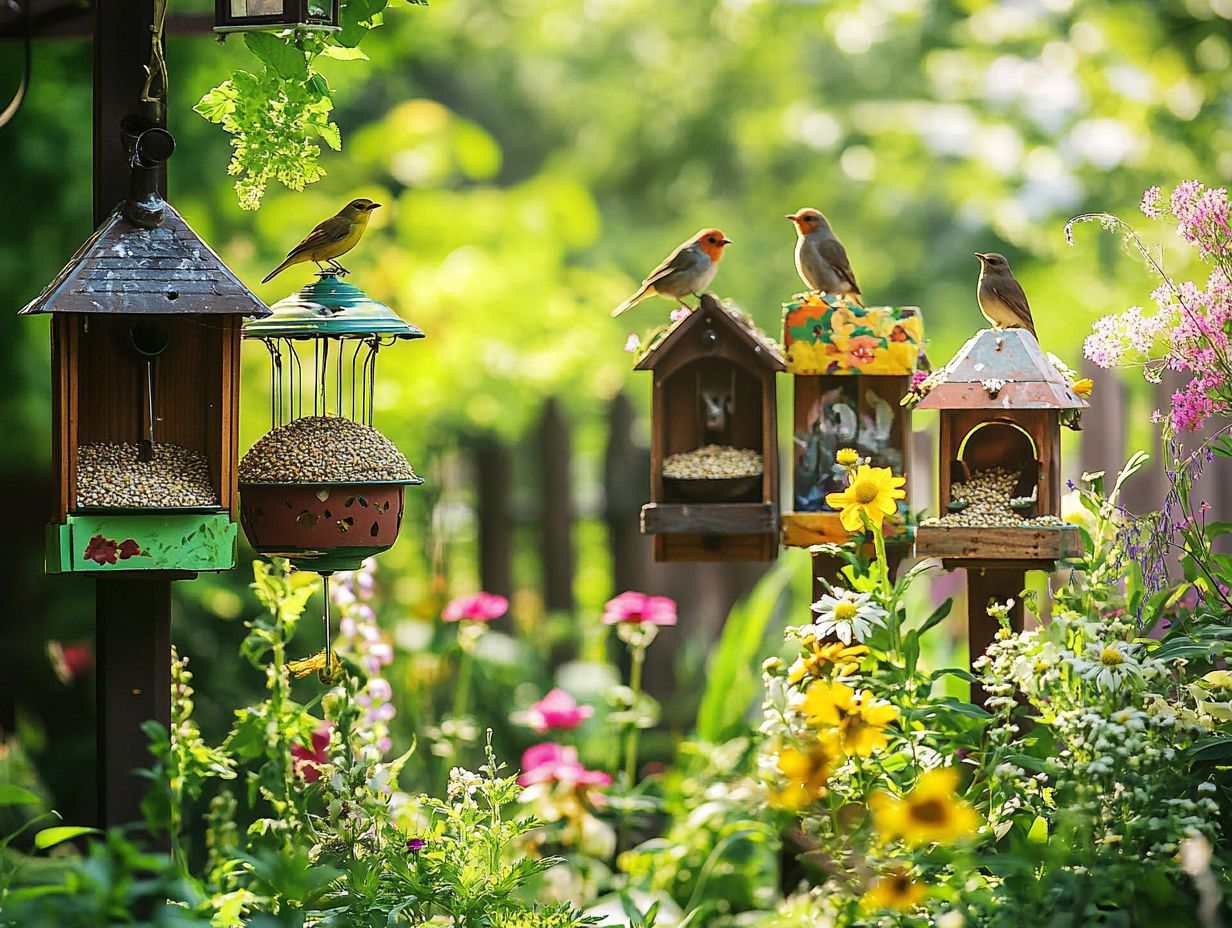
Feeder durability is crucial for a reliable bird feeding experience. Sturdier feeders made from recycled plastic or metal withstand squirrel damage and harsh weather.
Investing in robust designs enhances the longevity of your feeders. This creates a stable environment that invites various bird species to visit regularly. Many people agree that materials such as stainless steel provide excellent rust resistance and endure significant wear and tear.
By choosing well-constructed feeders, you’ll find yourself replacing them less frequently. This ultimately saves both time and money in the long run.
Making the right choice in feeder type and material leads to a more enjoyable and sustainable birdwatching experience. It actively contributes to a flourishing backyard ecosystem.
What Are the Pros and Cons of Each Type of Feeder?
Evaluating the pros and cons of each bird feeder type is crucial for making an informed decision. Understanding the top reasons to love bird feeders ensures that the feeders you choose will best meet your backyard bird-feeding goals and attract the species you desire.
Understanding the specific needs of various birds can significantly enhance your backyard experience. Different feeder designs cater to unique feeding behaviors; for instance, consider the best bird feeders for large areas that welcome a diverse range of species versus long, narrow feeders that cater to smaller, clinging birds.
Many people agree that the choice of materials, whether metal or wood, plays a vital role in durability and ease of maintenance. By carefully examining the advantages and disadvantages of each option, you can select feeders that entice your desired bird populations. They should also adapt seamlessly to seasonal changes and varying weather conditions.
What Are Some Additional Features to Look for in a Bird Feeder?
When selecting a bird feeder, considering additional features can truly elevate your bird feeding experience. Look for popular bird feeder designs that prioritize easy cleaning, resist squirrel damage, and offer versatility for feeding different bird species.
Choosing feeders with removable bases can significantly simplify your maintenance routine. It provides quick access when it s time to refill or clean! Opt for weather-resistant materials; they re essential for ensuring longevity and durability. This protects your feeder from rain and sun damage while maintaining its aesthetic appeal.
Seek out ideal designs that come in various styles and colors, allowing them to blend seamlessly with any garden. This also attracts more feathered visitors. Incorporating these features not only enhances functionality but also enriches your overall enjoyment of birdwatching.
How Can You Attract More Birds to Your Feeder?
Attracting more birds to your feeder is all about employing effective feeding techniques, selecting the right types of seeds, and crafting an inviting environment. This naturally encourages a variety of bird species to flock to your backyard.
To truly maximize avian interest, don t wait! Invest in various feeder types now, including tube, platform, and suet feeders, as each caters to different bird preferences. Sunflower seeds and nyjer thistle, for instance, are particularly enticing to finches and other small songbirds.
Enhancing your surroundings with native plants and shrubs not only provides natural shelter but also attracts insects that serve as a vital food source. It s widely recognized that placing feeders strategically near windows or natural cover allows birds to feel secure while they dine. By harmoniously blending these elements, you can cultivate a thriving birdwatching haven right outside your door.
What Are Some Common Mistakes to Avoid When Using Bird Feeders?
Common mistakes can limit the effectiveness of your bird feeders. Poor placement and neglecting maintenance can reduce the variety of bird species visiting your backyard.
To truly enhance your birdwatching experience, it’s essential to pay close attention to feeder placement. Position them in well-lit areas, away from potential predators, to create a safe haven for the birds.
Regular maintenance is essential. Clean your feeders frequently to prevent the spread of disease and keep the food fresh and enticing for birds.
Choosing high-quality, region-specific seeds can dramatically increase your chances of attracting diverse species.
Follow these tips to create an inviting space for your feathered friends!
Frequently Asked Questions
What are the 5 best bird feeders for my backyard?
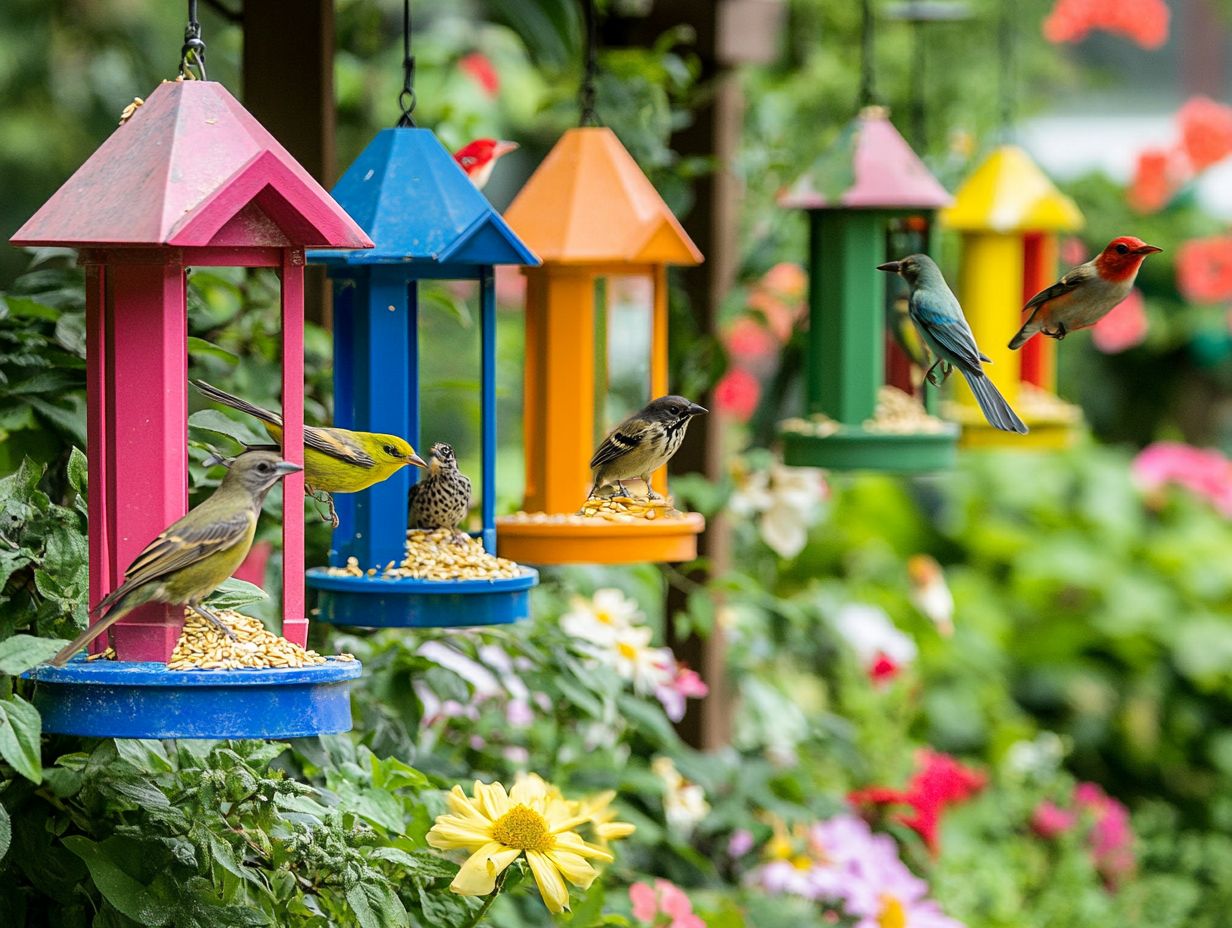
The 5 best bird feeders for your backyard include the tube feeder, platform feeder, hopper feeder, suet feeder, and hummingbird feeder.
How do I choose the right bird feeder for my backyard?
To choose the right bird feeder for your backyard, consider the types of birds you want to attract, the size and design of the feeder, and the type of food it can hold. For families, exploring the best bird feeders for kids can enhance the experience.
What is a tube feeder and why is it a popular choice?
A tube feeder is a long, cylindrical feeder that can hold a variety of bird seeds. It is popular because it attracts a wide variety of birds and can hold a large amount of food.
Can I use a platform feeder for ground-feeding birds?
Yes, a platform feeder can be used for ground-feeding birds such as doves, sparrows, and juncos. Just place the feeder in a sheltered area to protect the birds from predators.
What is the benefit of using a suet feeder in my backyard?
A suet feeder is a great choice for attracting insect-eating birds such as woodpeckers and nuthatches. It also provides high-energy food for birds during the winter months.
How can I keep my hummingbird feeder clean and safe for birds?
Act now to keep your hummingbird feeder clean and safe. Clean it regularly with hot water and vinegar, and change the nectar every few days. Avoid using red dye in the nectar as it can be harmful to bird populations. Using a removable base can simplify feeder maintenance.

